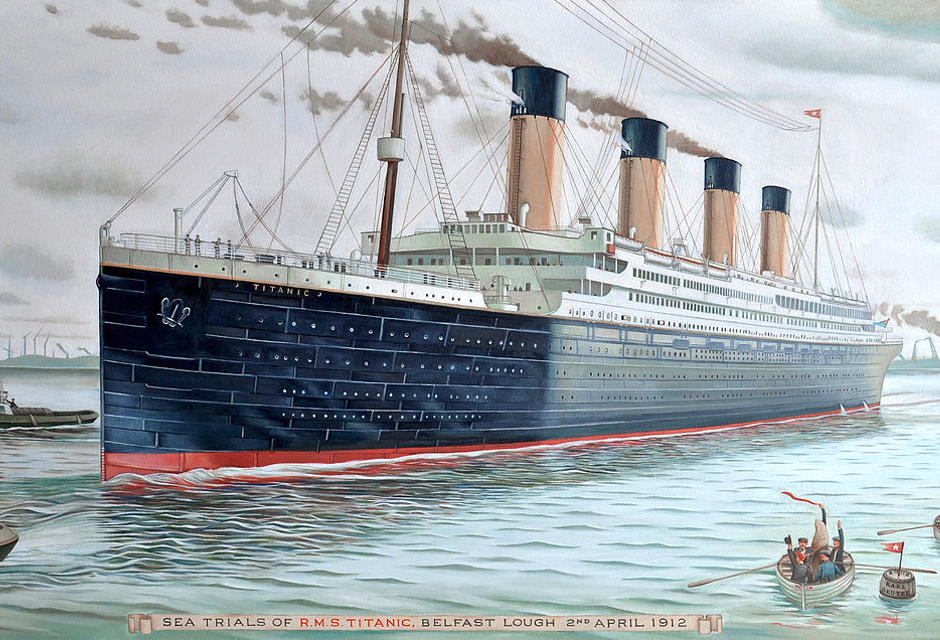On the morning of April 10, 1912, the Titanic set sail from Southampton, England on her maiden voyage. Four days later, it would be at the bottom of the Atlantic Ocean. At nearly 900 feet long, the Titanic was considered a marvel of the early 20th century, and its dramatic end was national news. Long before James Cameron’s Oscar hit, the tragic story of the has captivated people since that fateful day. Read on for some facts about the Titanic and her first and only voyage.
10 Titanic Facts
1. The Titanic had its own daily newspaper on board called the Atlantic Daily Bulletin. (source)
The Titanic boasted a notoriously luxurious experience compared to other ships of its time, and even offered its passengers a daily newspaper. The Atlantic Daily Bulletin included news, advertisements, stock prices, horse-racing results, and society gossip, keeping passengers informed and entertained during their voyage.
2. A lifeboat drill was scheduled to take place on the day the Titanic hit the iceberg. (source)
On April 14, 1912, the day the Titanic struck the iceberg, Captain Edward Smith inexplicably cancelled a scheduled lifeboat drill—to disastrous end. This decision has been a point of speculation and controversy, as the drill might have prepared both the crew and passengers better for the eventual evacuation.
3. There were only enough lifeboats for a third of the people onboard. (source)
Perhaps one of the most baffling Titanic ship facts is that the ship had only enough lifeboats for a fraction of the passengers. While the Titanic was capable of carrying 64 lifeboats, which would have been more than enough for the ship’s maximum capacity of 3500 people, the original plan for the ship only included 48. To make matters worse, that number was cut by more than half to make the deck look less cluttered and more aesthetically pleasing. Of the 20 lifeboats that were actually on board, only 18 of them were launched. While the available lifeboats, if filled properly could have accommodated 1178 people, 472 spaces went empty when all lifeboats were launched.
4. It was considered a symbol of modern safety in ship engineering. (source)
One of the most ironic tidbits in our Titanic fact file is that the ship was widely lauded by the contemporary press for being overly engineered for safety. Despite the small number of lifeboats, the ship had more than were required by regulations at the time, and was designed with numerous levels of fail safes to prevent sinking. The double-hull was comprised of 1-inch thick steel plates, and there were 16 compartments that could automatically seal when water was detected.
5. Three lucky dogs were saved in a lifeboat from the Titanic. (source)
Amid the chaos of the Titanic’s sinking, three dogs were saved by their owners and made it into lifeboats. These lucky canines included a Pomeranian named Lady and a Pekinese named Sun-Yat-Sen. The final dog’s name is unknown, but was a Pomeranian belonging to Martin and Elizabeth Jane Rothschild, who boarded lifeboat 6. Despite the “women and children only” rule, the small size of these pets allowed them access to rescue, even though some passengers initially objected.
6. There were Over 2,000 passengers aboard the Titanic when it sank and only 705 survived. (source)
Though the Titanic could technically carry over 3000 people, only about 2200 people were on board when the ship left England. Of those, 900 were crew. Roughly 1500 people perished when the ship sank, the largest portion being third class passengers, whose cabins were the furthest from the lifeboats. Of the 324 first-class passengers on board, 123 died. For the 280 second class passengers, 58% died. However, 537 of the 709 third class passengers died.
7. Musicians on the Titanic played on the deck outside for two Hours as the ship sank. (source)
One of the most enduring and poignant images from the Titanic disaster is of the ship’s musicians, who continued to play on the deck for two hours as the vessel sank. Led by Wallace Hartley, modern psychologists believe the band’s music may have helped calm passengers during the evacuation. Though historians are torn, it’s thought the band played either the hymn “Nearer My God to Thee,” or the waltz “Autumn.”
8. Women of all classes were more likely to survive the tragedy than men. (source)
The survival rate of a Titanic passenger is averaged at 38%, however, women as a whole were more likely to survive than man, regardless of class. In the Titanic’s sinking, women and children were given priority in lifeboat loading, following the maritime tradition of “women and children first.” This practice was not uniformly enforced, and there were significant variations depending on location and circumstances during the evacuation. First class men had a survival rate of 1/3, whereas third class women had a survival rate of 46%.
9. It took 73 years for the wreckage of the Titanic to be found. (source)
Despite its enduring presence in media and culture, Titanic’s wreckage remained undiscovered until 1985, a full 73 years after it sank. Oceanographer Dr. Robert Ballard and his team located the wreckage in 1985, carving his name into history. The discovery, about 12,500 feet below the surface of the Atlantic Ocean, was a monumental moment in maritime archaeology and brought renewed interest and investigation into the Titanic’s story. This discovery not only solved a long-standing mystery but also provided invaluable data about the ship’s final moments.
10. The wreckage will soon be gone forever. (source)
The Titanic wreckage, lying deep in the Atlantic Ocean, is slowly being consumed by iron-eating bacteria. These microorganisms are causing the ship’s metal structure to deteriorate, leading scientists to estimate that the wreck may be completely gone within 30 years.
Featured image photo credit: Karl Beutel, 2008. Originally found on Wikimedia. Image was resized and cropped. Creative Commons 3.0.




